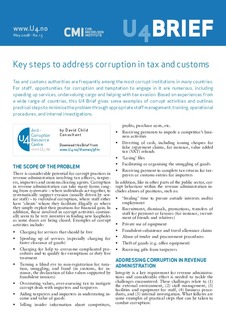| dc.contributor.author | Child, David | |
| dc.date.accessioned | 2018-01-04T08:16:11Z | |
| dc.date.available | 2018-01-04T08:16:11Z | |
| dc.date.issued | 2008-05-21 | |
| dc.identifier | oai:www.cmi.no:3041 | |
| dc.identifier.citation | Bergen: Chr. Michelsen Institute (U4 Brief 2008:15) 4 p. | |
| dc.identifier.uri | http://hdl.handle.net/11250/2474597 | |
| dc.description.abstract | Tax and customs authorities are frequently among the most corrupt institutions in many countries For staff, opportunities for corruption and temptation to engage in it are numerous, including speeding up services, undervaluing cargo and helping with tax evasion. Based on experiences from a wide range of countries, this U4 Brief gives some examples of corrupt activities and outlines practical steps to minimise the problem through appropriate staff management, training, operational procedures, and internal investigations. | |
| dc.language.iso | eng | |
| dc.publisher | Chr. Michelsen Institute | |
| dc.relation | U4 Brief | |
| dc.relation | 2008:15 | |
| dc.relation.ispartof | U4 Brief | |
| dc.relation.ispartofseries | U4 Brief 2008:15 | |
| dc.relation.uri | https://www.cmi.no/publications/3041-key-steps-to-address-corruption-in-tax-and-customs | |
| dc.subject | Corruption | |
| dc.subject | Revenue Administration | |
| dc.subject | Public Financial Management | |
| dc.subject | Public Financial Management and Procurement | |
| dc.title | Key Steps to Address Corruption in Tax and Customs | |
| dc.type | Report | |
